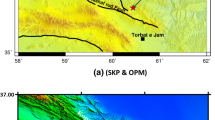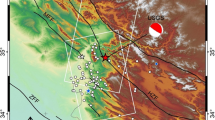Abstract
On November 25, 2016, the Mw 6.6 Aketao earthquake occurred in Xinjiang, western China. We used the combination of ascending Sentinel-1A, descending Sentinel-1B and ascending ALOS-2 PALSAR data to measure the coseismic deformation. The line-of-sight (LOS) coseismic deformation implies that the earthquake was dominated by right-lateral strike-slip. Ignoring the fault-perpendicular deformation, the fault-parallel and up–down deformation was extracted based on the combination of Sentinel-1A and 1B observations. Results show that the maximum fault-parallel deformation is ~ 13.7 cm at the north wall and the minimum is ~ −16.5 cm at the south wall of the Muji fault. Then, coseismic slip distribution was derived using the steepest descent method (SDM) based on a single-segment fault model using the three InSAR LOS observations as constraints. The slip distribution reveals two slip centers. The maximum slip of the eastern center is 0.5 m at a depth of 8.8 km, where the rake angle is ~ 181.2°. The maximum slip of the western center is 0.6 m at a depth of 10.8 km, where the rake angle is ~ 181.1°. The derived seismic moment obtained equals the Mw 6.6 earthquake. In this study, postseismic deformation time series in 1.5 years after the earthquake were retrieved from 26 multi-temporal Sentinel-1 descending scenes. The postseismic LOS deformation at the north and south walls of Muji fault both increases with time but in opposite directions. The cumulative deformation is 60–80 mm at the north wall, and –30 to −20 mm at the south wall. The postseismic deformation shows similar patterns with the coseismic deformation, and has the same mechanism. There is no obvious lock at the unbroken gap.











Similar content being viewed by others
References
Agram, P. S., Jolivet, R., Riel, B., Lin, Y. N., Simons, M., Hetland, E., et al. (2013). New radar interferometric time series analysis toolbox released. Eos Trans. AGU,94, 69.
Agram, P., Jolivet, R., & Simons, M. (2012). Generic InSAR analysis toolbox (GIAnT)—User guide. http://earthdef.caltech.edu.
Agram, P. S., & Simons, M. (2015). A noise model for InSAR time series. Journal of Geophysical Research: Solid Earth. https://doi.org/10.1002/2014jb011271.
Berardino, P., Fornaro, G., Lanari, R., & Sansosti, E. (2002). A new algorithm for surface deformation monitoring based on small baseline differential SAR interferograms. IEEE TGRS,40, 2375–2383.
Bie, L., Hicks, S., Garth, T., Gonzalez, P., & Rietbrock, A. (2018). ‘Two go together’: Near-simultaneous moment release of two asperities during the 2016 Mw 6.6 Muji, China earthquake. Earth and Planetary Science Letters,491, 34–42.
Cavalie, O., Doin, M. P., Lasserre, C., & Briole, P. (2007). Ground motion measurement in the Lake Mead area, Nevada, by differential synthetic aperture radar interferometry time series analysis: Probing the lithosphere rheological structure. Journal of Geophysical Research,112(B3), B03403. https://doi.org/10.1029/2006jb004344.
Chen, J., Li, T., Sun, J., et al. (2016). Coseismic Surface Ruptures and Seismogenic Muji fault of the 25 November 2016 Aketao Mw 6.6 Earthquake in Northern Pamir. Seismology and Geology.,38(4), 1160–1174. (in Chinese).
Chen, C. W., & Zebker, H. A. (2001). Two-dimensional phase unwrapping with use of statistical models for cost functions in nonlinear optimization. Journal of the Optical Society of America A,18, 338–351.
Chevalier, M. L., Li, H., Pan, J., Pei, J., Wu, F., Xu, W., et al. (2011). Fast slip-rate along the northern end of the Karakorum fault system, western Tibet. Geophysical Research Letters,38, L22309.
Diao, F., Xiong, X., Wang, R., Zheng, Y., Walter, T. R., Weng, H., et al. (2014). Overlapping post-seismic deformation processes: afterslip and viscoelastic relaxation following the 2011 Mw 9.0 Tohoku (Japan) earthquake. Geophysical Journal International,196, 218–229.
Doin, M. P., Lasserre, C., Peltzer, G., Cavalie, O., & Doubre, C. (2009). Corrections of stratified tropospheric delays in SAR interferometry: Validation with global atmospheric models. Journal of Applied Geophysics,69(1), 35–50.
Du, Y., Aydin, A., & Segall., P. (1992). Comparison of various inversion techniques as applied to the determination of a geophysical deformation model for the 1983 Borah Peak earthquake. Bulletin of the Seismological Society of America, 82(4), 1840–1866.
Feng, W. P., Tian, Y., Zhang, Y., Samsonov, S., Almeida, R., & Liu, P. (2017). A slip gap of the 2016 Mw 6.6 Muji, Xinjiang, China, earthquake inferred from Sentinel-1 TOPS interferometry. Seismological Research Letters,88(4), 1–11.
Fialko, Y., Simons, M., & Agnew, D. (2001). The complete (3-D) surface displacement field in the epicentral area of the 1999 Mw 7.1 Hector Mine earthquake, California, from space geodetic observations. Geophysical Research Letters,28, 3063–3066.
Goldstein, R. M., & Werner, C. L. (1998). Radar interferogram filtering for geophysical applications. Geophysical Research Letters,25(21), 4035–4038.
He, P., Dingb, K., & Xu, C. (2018). The 2016 Mw 6.7 Aketao earthquake in Muji range, northern Pamir: Rupture on a strike-slip fault constrained by Sentinel-1 radar interferometry and GPS. International Journal of Applied Earth Observation and Geoinformation,73, 99–106.
Jolivet, R., Grandin, R., Lasserre, C., Doin, M. P., & Peltzer, G. (2011). Systematic InSAR tropospheric phase delay corrections from global meteorological reanalysis data. Geophysical Research Letters,38, L17311. https://doi.org/10.1029/2011GL048757.
Klein, E., Fleitout, L., Vigny, C., & Garaud, J. D. (2016). Afterslip and viscoelastic relaxation model inferred from the large-scale post-seismic deformation following the 2010 Mw 8.8 Maule earthquake (Chile). Geophysical Journal International,205, 1455–1472.
Laske, G., Masters, G., Ma, Z., & Pasyanos, M. (2013). Update on CRUST1.0—A 1-degree Global Model of Earth’s Crust. Geophys. Res. Abstracts, 15, Abstract EGU2013-2658.
Li, J., Liu, G., Qiao, X., et al. (2018). Rupture Characteristics of the 25 November 2016 Aketao earthquake (Mw 6.6) in Eastern Pamir revealed by GPS and teleseismic data. Pure and Applied Geophysics,175, 573–585.
Massonnet, D., Rossi, M., Carmona, C., Adaragna, F., Peltzer, G., Feigl, K., et al. (1993). The displacement field of the Landers earthquake mapped by radar interferometry. Nature,364, 138–142.
Qu, C., Zuo, R., Shan, X., Hu, J., & Zhang, G. (2017). Coseismic deformation of the 2016 Taiwan Mw 6.3 earthquake using InSAR data and source slip inversion. Journal of Asian Earth Sciences,148, 96–104.
Rosen, P. A., Gurrola, E., Sacco, G. F., & Zebker, H. (2012). The InSAR scientific computing environment. European Conference on Synthetic Aperture Radar, 730-733, VDE.
Wang, X., Liu, G., Yu, B., Dai, K. A., Zhang, R. A., Chen, Q., et al. (2014). 3D coseismic deformations and source parameters of the 2010 Yushu earthquake (China) inferred from DInSAR and multiple-aperture InSAR measurements. Remote Sensing of Environment,152, 174–189.
Wang, R., Parolai, S., Ge, M., Jin, M., Walter, T. R., & Zschau, J. (2013). The 2011 Mw 9.0 Tohoku earthquake-comparison of GPS and strong-motion data. Bulletin of the Seismological Society of America,103(2B), 1336–1347. https://doi.org/10.1785/0120110264.
Wang, R., Schurr, B., Milkereit, C., Shao, Z., & Jin, M. (2011). An improved automatic scheme for empirical baseline correction of digital strong-motion records. Bulletin of the Seismological Society of America,101, 2029–2044.
Wang, S., Xu, C., Wen, Y., Yin, Z., Jiang, G., & Fang, L. (2017). Slip model for the 25 November 2016 Mw 6.6 Aketao earthquake, western China, revealed by Sentinel-1 and ALOS-2 Observations. Remote Sensing,9, 325.
Acknowledgements
This work was supported by the National Natural Science Foundation of China under grants nos. 41874024, 41304002, 41174004 and 41611530702, and the Special Fund of the Institute of Earthquake Forecasting, China Earthquake Administration under grant no. 2018IEF0303. The Sentinel-1A/1B SAR data were provided by the European Space Agency (ESA) through the Scientific Data Hub. The figures in this paper were prepared using Generic Mapping Tools. The 30-m spatial resolution SRTM DEM data were downloaded from NASA’s Land Processes Distributed Active Archive Center (LP DAAC) located at the USGS Earth Resources Observation and Science (EROS) Center.
Author information
Authors and Affiliations
Corresponding author
Additional information
Publisher's Note
Springer Nature remains neutral with regard to jurisdictional claims in published maps and institutional affiliations.
Rights and permissions
About this article
Cite this article
Dong, Y., Meng, G. & Hong, S. Coseismic and Postseismic Deformation of the 2016 Mw 6.6 Aketao Earthquake from InSAR Observations and Modelling. Pure Appl. Geophys. 177, 265–283 (2020). https://doi.org/10.1007/s00024-019-02092-9
Received:
Revised:
Accepted:
Published:
Issue Date:
DOI: https://doi.org/10.1007/s00024-019-02092-9




